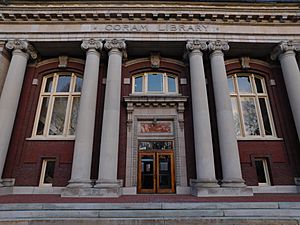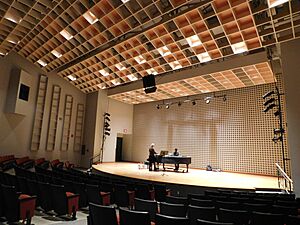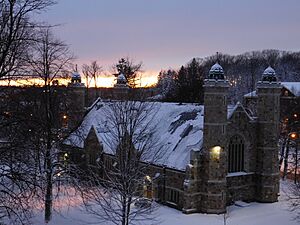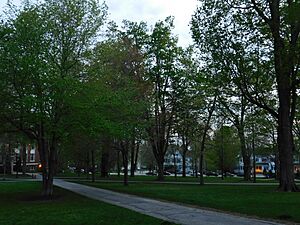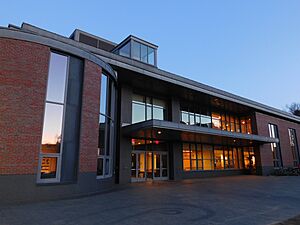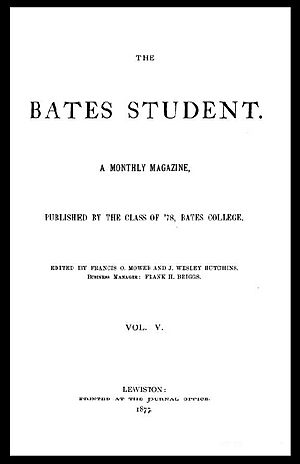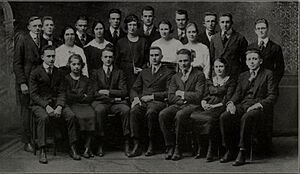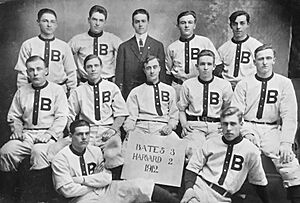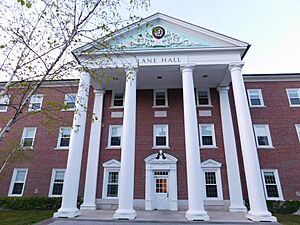Bates College facts for kids
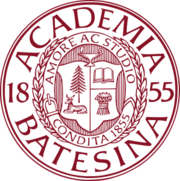 |
|
| Latin: Academia Batesina | |
|
Former name
|
Maine State Seminary (1855–1863) |
|---|---|
| Motto | Amore Ac Studio (Latin) |
|
Motto in English
|
With Ardor and Devotion by Charles Sumner |
| Type | Private liberal arts college |
| Established | March 16, 1855 |
| Accreditation | NECHE |
|
Academic affiliations
|
Space-grant, Annapolis Group |
| Endowment | $447 million (2024) |
| Budget | $131 million (2023) |
| Chairman | Gregory Ehret |
| President | Garry Jenkins |
|
Academic staff
|
200 (2024) |
| Undergraduates | 1,800 (2024) |
| Location |
,
,
U.S.
44°6′20″N 70°12′15″W / 44.10556°N 70.20417°W |
| Campus | Campus: 133 acres Bates Mountain: 600 acres Coastal Center: 80 acres Total: 813 acres |
| Colors | Garnet |
| Nickname | Bobcats |
|
Sporting affiliations
|
|
Bates College is a private college in Lewiston, Maine. It focuses on a wide range of subjects, including humanities, social sciences, and natural sciences. The college campus covers about 813 acres. This includes its main campus, a large nature preserve called "Bates-Morse Mountain", and a coastal center. Bates is known for being a smaller college, with about 1,800 students.
The college was started in 1855 by Oren Burbank Cheney, who was against slavery, and Benjamin Bates IV, a wealthy textile businessman. Bates College was the first college in New England to allow both boys and girls to study together. It is also the third-oldest college in Maine. Students at Bates must complete a special project or paper before they graduate.
Bates is part of the "Maine Big Three" colleges. Its sports teams, called the Bates Bobcats, compete in NCAA Division III. The college has many traditions and has produced successful alumni, including scholars, politicians, and Olympians. Bates is also home to the Stephens Observatory and the Bates College Museum of Art.
History of Bates College
How Bates College Started
Oren Burbank Cheney, who founded Bates College, cared deeply about fairness for all people. He worked on issues like racial and gender equality. In 1855, he helped create the Maine State Seminary. This school was special because it was the first in New England to allow both boys and girls to attend.
Later, a generous businessman named Benjamin Bates IV donated a lot of money to the school. Because of his help, the school was renamed Bates College in 1863. Two years later, in 1865, Mary Mitchell Birchall became the first woman in New England to earn a college degree from Bates.
Bates College chose not to have fraternities or sororities. This was because the founder believed they were too exclusive. The college's motto, Amore Ac Studio, means "With Ardor and Devotion." This motto was suggested by U.S. Senator Charles Sumner.
Bates in the 1900s
In the early 1900s, Bates College became more well-known across the country. The Bates Outing Club, which organizes outdoor adventures, was started in 1920. It was one of the first college outing clubs to include both men and women.
The college's debate team, the Brooks Quimby Debate Council, was also very famous. It was the first college debate team in the U.S. to compete internationally. They even debated against teams from the University of Oxford!
During World War II, many students joined the military. Bates College helped by hosting a special Navy training program. Future U.S. Attorney General Robert F. Kennedy was one of the students who attended Bates during this time.
In the 1960s, Bates joined with Colby College and Bowdoin College to form the Colby-Bates-Bowdoin Consortium. This group of colleges works together on academics and sports. In 1984, Bates was one of the first colleges to make SAT and ACT scores optional for applying. This meant students could choose whether or not to send their test scores.
Bates in the 2000s
In 2012, Clayton Spencer became the president of Bates. She worked to make the college more diverse and to offer more financial aid. In recent years, Bates has received very large donations to help support the college.
In 2023, Garry Jenkins became the first Black president of Bates College. The college continues to focus on helping students from all backgrounds.
What Students Learn
Bates College offers 36 main subjects and 25 smaller subjects. Students can earn a Bachelor of Arts (B.A.) or a Bachelor of Science (B.S.) degree. About 1,800 students attend Bates, and many of them study abroad for a semester.
The school year has three parts: two main semesters and a "Short Term" in the spring. During the five-week Short Term, students take only one class. This allows them to study a topic in great detail. Students must complete at least two Short Terms to graduate.
Some of the most popular subjects at Bates include biology, economics, psychology, and English. Bates also has special programs like environmental studies and neuroscience.
Bates College has a program where students can study engineering. They spend three years at Bates and then two years at an engineering school like Dartmouth College or Columbia University. This allows them to earn degrees from both Bates and the engineering school.
How Students Learn
Students at Bates start with a special first-year class. This class helps them prepare for their studies. Before graduating, every student completes a "senior thesis" or a "capstone project." This is a big research project that shows what they have learned in their main subject.
Research and Teachers
Bates College receives money for research, and students can get grants to do their own projects. The college's Harward Center helps students do research that benefits the community.
Bates College has been important in scientific discoveries. For example, a Bates alumnus named George S. Hammond helped create new ideas in chemistry. Another alumnus, Steven Girvin, helped develop an important concept in physics.
The Stephens Observatory is located on top of the Carnegie Science Hall. It has a powerful telescope that students and scientists use to study space.
Bates College has about 200 teachers for its 1,800 students. This means there are about 10 students for every teacher. Most teachers have the highest degree in their field.
Mount David Summit
Every year, Bates College holds the Mount David Summit. This event is a chance for students to show off their research, art, and other projects. It's named after Mount David, a hill on campus. Students give presentations, show films, and share their work with the college community.
How to Get Into Bates
| Admissions statistics | |
|---|---|
|
2019 entering
classChange vs. 2014 |
|
| Admit rate | 12.1%
(
|
| Yield rate | 50.0%
(
|
| Test scores middle 50%* | |
| SAT EBRW | 630–750 |
| SAT Math | 640–730 |
| ACT Composite | 29–33 |
| High school GPA† | |
| Top 10% | 71.4
(
|
| Top 25% | 89.5
(
|
| Top 50% | 99.0
(
|
|
|
Getting into Bates College can be challenging. For the class that started in 2019, only about 12% of all applicants were accepted. Bates has a "Test Optional Policy." This means students can choose whether or not to send their SAT or ACT scores when they apply.
How Much It Costs and Financial Help

For the 2024–25 school year, the total cost to attend Bates College (including tuition, room, and food) was about $85,370. Bates tries to help students who need financial assistance. They meet the full financial need for all admitted U.S. students.
Bates does not offer special scholarships for good grades or athletic skills. They focus on helping students based on their financial need.
Student Population
Bates College has students from all over the U.S. and from many different countries. About 27% of U.S. students are students of color. About 12% of admitted students are the first in their family to go to college. Many students come from public schools, and many also come from private schools. Most students who start at Bates stay for all four years.
College Rankings
| USNWR Liberal Arts College | 26 |
|---|---|
| Washington Monthly Liberal Arts | 28 |
| Forbes | 80 |
Bates is considered one of the "Little Ivies" and "Hidden Ivies." These are groups of highly respected colleges. U.S. News & World Report ranked Bates tied for 26th among all liberal arts colleges in the nation in 2025. Forbes ranked Bates 80th among all U.S. colleges and universities in 2025.
Campus Life
Bates College is located in Lewiston, Maine. The town has a rich history with people from French Canadian and Somali backgrounds. Bates works to connect with the local community through its Harward Center for Community Partnerships.
The buildings at Bates College have a classic American style. Many of them look like older homes and buildings from the Victorian era. The campus has a main area with academic buildings, sports fields, and dorms.
Bates has a large library system with over 1 million items. The George and Helen Ladd Library alone has over 620,000 books and other materials. The libraries also hold important historical documents, like copies of the original Constitution of Maine.
Students live in 33 Victorian Houses, 9 residential halls, and one residential village. The main administration building, Lane Hall, houses the offices of the college president and other leaders.
Olin Arts Center
The Olin Arts Center is where students study art and music. It has soundproof studios, classrooms, practice rooms with pianos, and a large concert hall. Many famous artists have visited and performed at the center.
Bates College Museum of Art
The Bates College Museum of Art was founded in 1955. It has about 5,000 pieces of modern and historical art from around the world. The museum also has many original artworks by Marsden Hartley. It hosts talks, workshops, and student exhibits. About 20,000 people visit the museum each year.
Bates-Morse Mountain Area
The Bates-Morse Mountain Conservation Area is a large natural area of 600 acres. It has salt marshes and coastal lands. Bates students use this area for classes, research, and outdoor activities. The college helps protect the plants and animals that live there.
Student Life
Bates College is known for its excellent dining program. The main dining area, The Commons, serves meals made with food from local Maine suppliers. There is also an on-campus restaurant called The Den.
Bates celebrates Martin Luther King, Jr. Day every year by canceling classes. Instead, students attend talks by well-known scholars who speak about fairness and equality.
The college has over 110 clubs and organizations. The largest is the Outing Club, which organizes trips like canoeing, kayaking, and camping. Even though Bates doesn't have fraternities or sororities, students have many social groups.
Student News and Radio
The Bates Student
The Bates Student is the college's oldest newspaper, started in 1873. It is one of the oldest college newspapers in the U.S. that has been published continuously. It is also the oldest college newspaper for both boys and girls.
WRBC
WRBC is the college radio station of Bates College. It started in 1958. In 2015, it was ranked as one of the best college radio stations in the U.S. and Canada.
A Cappella Music
Bates College has five singing groups that perform without instruments, called a cappella groups. There are groups for all boys, all girls, and mixed groups.
Brooks Quimby Debate Council
The Brooks Quimby Debate Council is the oldest college debate group in the U.S. that includes both boys and girls. It was the first college debate team to compete internationally. The team has been called "America's most prestigious debating society." They often debate against teams from Oxford, Cambridge, and Dartmouth College.
College Traditions
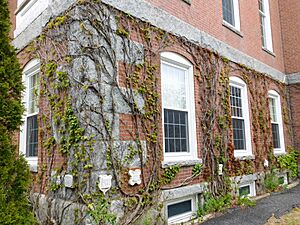
Ivy Day
On Ivy Day, graduating students place a special stone or plaque on one of the campus buildings. This stone represents their class and its history at the college. This tradition is also shared with other famous universities.
Winter Carnival
The Winter Carnival is a tradition that is almost 100 years old. It's a four-day event with performances, dances, and games. Students build large snow sculptures and participate in fun activities. One popular event is the "Puddle Jump," where students jump into a hole cut in Lake Andrews!
Sports at Bates
Bates College's mascot is the bobcat, and its color is garnet. The college competes in NCAA Division III sports as part of the New England Small College Athletic Conference (NESCAC). This conference includes other colleges like Amherst, Bowdoin, and Colby. Bates has a long-standing sports rivalry with Bowdoin and Colby, especially in football.
The women's rowing team at Bates is very successful. As of 2016, they were ranked first in NCAA Division III rowing. The men's rowing team has also achieved high rankings. Bates has won the Colby-Bates-Bowdoin Chase Regatta many times.
The college has 31 varsity sports teams and 9 club teams. These include sailing, cycling, ice hockey, rugby, and water polo. Bates has produced 12 Olympians, including one who won a gold medal in rowing at the 2008 Beijing Olympics.
Caring for the Environment
Bates College is committed to being environmentally friendly. In 2007, they promised to reduce their impact on the climate. Their dining hall, The Commons, is designed to be energy efficient. It uses natural light and special cooling systems.
Many buildings on campus use energy-saving features like motion sensors and efficient heating. Bates uses a special system that provides steam for heating and reduces electricity use.
The college has many environmental clubs. These clubs help students learn about climate change and get involved in protecting the environment. The U.S. Environmental Protection Agency (EPA) has recognized Bates for using a lot of renewable energy. In 2019, Bates College achieved "complete carbon neutrality," meaning it balances out its carbon emissions.
How Bates is Managed
Bates College is run by its main administration, located in Lane Hall. The current president is Garry Jenkins, who started in July 2023. The college has a board of trustees that helps make important decisions.
Money and Donations
Bates College is a nonprofit organization. It has an endowment, which is money saved up to support the college. The college has worked hard to raise money for its programs and facilities. For example, from 2017 to 2022, Bates raised about $300 million.
Students have asked the college to avoid investing in companies that use fossil fuels. The college explained that changing all its investments would be very costly and could hurt its ability to support students and programs. However, Bates did share its investment strategy and continues to focus on sustainability.
Famous People from Bates College
-
Bryant Gumbel, journalist
-
Benjamin Mays, civil rights leader
-
E. Robert Kinney, former CEO of General Mills
-
Jared Golden, U.S. Congressman
-
Edmund Muskie, former U.S. Secretary of State
-
Robert F. Kennedy, American politician
Many Bates College alumni have become leaders in various fields. These include science, politics, medicine, law, education, and business. As of 2015, there are 24,000 Bates College alumni.
Some famous alumni include:
- Benjamin Mays, a key leader in the American civil rights movement.
- Edmund Muskie, who served as a U.S. Secretary of State and U.S. Senator.
- Robert F. Kennedy, an American politician and lawyer.
- Bryant Gumbel, a well-known journalist.
- Elizabeth Strout, a Pulitzer Prize-winning writer.
- Jared Golden, a current U.S. Congressman.
Bates alumni have also included Olympians who competed in various sports.
See also
 In Spanish: Bates College para niños
In Spanish: Bates College para niños
- Liberal arts colleges in the United States
- List of colleges and universities in Maine
- New England Small College Athletic Conference
- The Hidden Ivies


